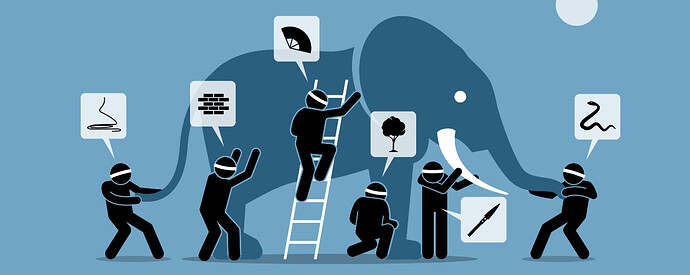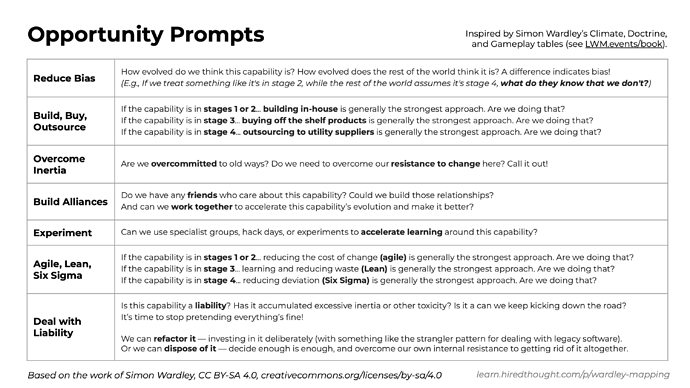For our 2022 company retreat we engaged Ben Mosior from Hired Thought to teach us wardley-maps, originally created by Simon Wardley swardley.
Ben’s mapping process, boiled down
Ben has a fast and easy way to get people Wardley Mapping within just a few minutes. This was his “intro 90 minutes” session, and we came out of it with every single team member having a map of their own.
See The Five Minute Wardley Map.pdf (103.2 KB)
Boiled down, the process simply is:
- Define a USER
- List the user’s NEEDS
- List the CAPABILITIES you have to fulfill those Needs
- Organize the Needs and Capabilities into a value chain, defining dependencies
- Place your Value Chain on a field with each of the 4 Stages of Evolution.pdf (115.5 KB)
Now you have a Wardley Map! ![]()
There is a lot going on during each of these steps, but this serves as a reminder to our team members who participated in the workshop. Here are a few takeaways:
- as you discuss the proper terms to use in your Value Chain, many related topics will pop up. “Parking Lot” these on the side for future mapping discussions
- anytime you notice multiple different needs, list them as alternatives. This is a “socket” that something needs to be plugged into, but you might not know exactly what at this point. In other words, a decision needs to be made.
- generally things higher up the value chain are more visible to Users
- Hidden dependencies are risky. Broken parts at the bottom of your Value Chain will hurt everything above.
- “assume your users will have contradictory needs”
- just by moving the pieces about the board, you can create more discussion
Why make maps?
The goal in using a map to guide discussions is to avoid “false agreement” by ensuring everyone agrees on state.
making things discussable
Can we create enough of a common view of the “elephant” to have a meaningful discussion, but not have so much overlap in our views that we lose any diversity
Diversity of perspective helps us not get killed by the market.
“All models are wrong, but some are useful.” is useful to remember, but George Box went on to say:
Since all models are wrong the scientist must be alert to what is importantly wrong. It is inappropriate to be concerned about mice when there are tigers abroad.
Thus Ben advises us to use Wardley Maps to:
Look for tigers, not mice.
Manage evolution, make decisions
How evolved something is dictates its qualities.
By placing your Value Chain on a Wardley Map you assert qualities about that particular aspect. You also surface your assumptions and make conversations clearer, allowing you to avoid “false agreement.”
A Wardley Map gives you a landscape to make decisions. Once you have a map, now you can decide on your strategy. Where should you strategically intervene?
A Wardley Map is a map of “wheres”
Once you have your map, Ben has provided a number of thought-provoking “opportunity prompts” to help you make some decisions.
Next Steps
Things to look into to level up:
- strategy cycle
- climate patterns: what’s happening in the market
- doctrine: readiness for your org
- leadership: influencing the market
Wardley Mapping Learning Plan:
- First, learn to read maps: (4m video)
- Then, learn to make maps: (10m video)
- Next, read Simon Wardley’s free book:
a. Start with the summary: (video series)
b. Then read it, bit by bit: (web | pdf | audiobook | print) - As you read the book, also:
a. Explore example maps: (here and here)
b. Listen in on mapping conversations: (video series) - Then practice, practice, practice:
a. Make maps, alone: (reference | template | workbook)
b. Make maps, alone in meetings (template)
c. Practice thinking w/ maps: (climate | doctrine | leadership)
d. Practice making maps, with colleagues: (article) - Pursue high quality action: (article)

